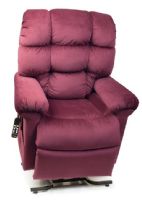 Written by Mike Price, OT
Written by Mike Price, OT
It’s common to reference the Trendelenburg Position in product descriptions for medical furniture, but not everyone knows exactly what that is. Use of the Trendelenburg position has long been employed across multiple medical disciplines including surgery, treatment of shock and hypotension, and respiratory ailments. Through the years, it’s been discontinued in some fields, while it’s still considered a helpful and valid treatment in others. We are inclined to agree, and you can find many examples of furniture utilizing the Trendelenburg position in our product listings.
The Trendelenburg Position places the patient on a 15- to 30-degree incline, positioning the legs higher than the head. There’s a modified version where only the legs are raised. The Reverse Trendelenburg Position places the patient on the same incline, but the head is higher than the legs.
The Trendelenburg position is named after German surgeon Friedrich Trendelenburg (1844-1924), who created it to improve the exposure of the pelvic organs during surgery.
During World War I, American physiologist Walter Cannon used the Trendelenburg position as a treatment for shock because it increased venous return to the heart, cardiac output, and improved organ perfusion. Years later he reversed his opinion on its benefits, but by then it was widely in use. Today, it is employed in the early management of hypotension.
 | Hospital Bed Frame with Four Section and Trendelenburg Function - UltraCare XT by Joerns View Product |
A Trendelenburg hospital bed remains flat as it inclines the foot end of the bed above the head and many models can move into the reverse Trendelenburg position which inclines the head rather than the feet yet maintains a flat surface. Since they may have different degrees of incline, it’s important to note that when shopping.
 | AllCare Adjustable Floor Bed by Med Mizer View Product |
Floor beds minimize the risk of an accidental fall from bed. They go to the floor so users are not in danger of a significant fall, and they raise up to full height to facilitate care and enable adjustable Trendelenburg floor beds include the ability to place the patient in a Trendelenburg and Reverse Trendelenburg positions when raised up off the floor.
 | Rotating Bed - ActiveCare Standard Hi-Low Bed by Med-Mizer View Product |
When it was first utilized, the Trendelenburg position was used for surgery to leverage gravity to move organs out of the way during abdominal surgery. It’s now used in adjustable beds because consumers appreciate the option. For one thing, it seems to temporarily relieve pressure on the lower abdomen and back, and some consumers receive recommendations from a health care providers to target specific medical conditions.
 | Ida Bed - Electric Adjustable Safety Bed by Kayserbetten View Product |
A safety bed is designed to prevent a child from leaving the bed at night without supervision. Also referred to as institutional beds, adaptive beds, enclosed canopy beds, special needs beds, and child-safe beds, a safety bed with the Trendelenburg Position provides maximum positional adjustability. Check out Safety Beds: What Are They and Who Needs One? to find out more about who can benefit from a safety bed and the features these beds provide users.
Multi-position geri chairs, also known as Trendelenburg or Zero Gravity geri chairs, provide beneficial above-the-heart feet elevation following surgery, promoting better circulation to enhance recovery. They also allow above-the-head elevation of the feet to benefit vein conditions, swelling/edema, pregnancy, lymphedema, and cellulitis. Read Geri Chair Buying Guide: How to Choose the Right One for more information on choosing the best geri chair for your situation.
 | Golden Technologies MaxiComfort Ultimate Recline Cloud Series Lift Chair with Trendelenburg View Product |
The Trendelenburg position with a lift chair elevates the feet above the heart, and the heart is elevated above the head. This positioning benefits lusers with edema, swelling, diabetes, congestive heart failure, neuropathy, and blood circulation deficiency. Because these chairs have a significant foot print, measuring to fit the user and the available space will ensure you don’t buy an expensive chair that is not a good fit.
 | Flat Top Trendelenburg Imaging Table View Product |
Imaging tables that can achieve the Trendelenburg and Reverse Trendelenburg positions provide positional stability that allow for the best opportunity for clear imaging. Gravity helps shift organs with the Trendelenburg position to provide the best view.
 | Oakworks PF 400 Exam Table View Product |
The Trendelenburg position in exam and treatment tables allows a surgeon greater access to pelvic organs. This is helpful for procedures like colorectal, gynecological, and genitourinary surgery. This position is also recommended by the American Society of Anesthesiologists as the best position for a central line insertion. This positioning is not advisable for use with obese patients. For more information, check out our list of Treatment Tables Trendelenburg Position.
Stretchers use the Trendelenburg positions for passive leg-raising to determine fluid response. Elevating a patient's feet higher than the head raises blood pressure, and perhaps cause blood to flow from the legs to the trunk. A recent study found it may be a non-invasive treatment for supraventricular tachycardia. A head-down position for the patient, increases venous return and stimulates baroreceptors to produce an increased vagal tone and subsequent decrease in heart rate, with resolution of the tachycardia after about 30 seconds.
Generally, use of the Trendelenburg Position is not recommended for obese patients. It can disrupt respiration to a dangerous degree for severely overweight people.
Patients of normal weight can safely tolerate prolonged periods or more than 6 hours of steep Trendelenburg. However, many researchers advocate for limiting steep Trendelenburg time to less than 5 hours. Excess pressure on the head may result in injury to the cervical spine. Caudad pressure on the shoulders during Trendelenburg may result in stretch injury to the brachial plexus. Prolonged lithotomy positioning increases patient risk for common peroneal nerve injury, compartment syndrome, and rhabdomyolysis.
A: This position is integrated into most profiling and adjustable beds. Placing the user’s head down and elevating the feet, the whole body is sloping down with the feet higher than the head.
A: A modified version of Trendelenburg, Reverse Trendelenburg position is also known as anti-Trelenburg. It is used for laparoscopic surgeries including gallbladder, biliary tract, stomach procedures, and head and neck surgeries. In Reverse Trendelenburg, the patient’s head is up, with the feet are positioned down.
A: If correctly monitored, Trendenburg positioning is safe for patients who are not obese and who do not have contraindicating conditions. The Trendelenburg position allows a surgeon greater access to pelvic organs, helpful for procedures like colorectal, gynecological, and genitourinary surgery. As with all surgical positions, risks must be assessed, and these include diminished lung capacity, tidal volume and pulmonary compliance, venous pooling toward the patient’s head, and sliding and shearing.
A: The position remains common in the early management of a hypotension. Short periods of resting in the position increases circulation and helps patients relax. It also might help relieve tension in the legs and spine.
A: Yes, it is possible to sleep in the Trendelenburg position, but it should be monitored as it can have a negative effect if the time spent in the position is not limited.
A: Rehabmart does have Trendelenburg beds available. We recommend the UltraCare XT Four Section Joerns Hospital Bed Frame with Trendelenburg.
A: Reverse Trendelenburg position decreases central venous pressure without significantly decreasing the systolic blood pressure.
A: With the Trendelenburg position, gravity pulls the blood down toward the vital organs of the brain and heart. This increases blood volume and cardiac output and a rise in blood pressure.
A: Yes. It is often the first measure implemented for treatment of hypotension.
A: Surgery patients are placed in the Trendelenburg position for abdominal and gynecological procedures for better access to organs. It is also used to help reverse hypotension, treat low cardiac output, insert central IV catheters, for postural drainage, to reduce leg swelling, and to help move heavy patients up in bed.
Now that you know what the Trendelenburg Position and Reverse Trendelenburg Position are and the benefits of these positions, the use of equipment offering this positioning might be appealing to manage hypotension, increase circulation and encourage relaxation, or relieve tension in the legs and spine. Use of the Trendelenburg Position should be closely monitored by a physician, so your doctor should be consulted with any questions you have about purchasing a product to use for Trendelenburg positioning.
For more information on the Trendelenburg Position and medical equipment that has the capability for this positioning, visit Caregiver University.
>> Shop Adjustable Beds <<
Co-Founder of Rehabmart and an Occupational Therapist since 1993. Mike has spent his professional career working in multiple areas of Occupational Therapy, including pediatrics, geriatrics, hand therapy, ergonomics and inpatient / outpatient rehabilitation. Mike enjoys writing articles that help people solve complex therapeutic problems and make better product choices.